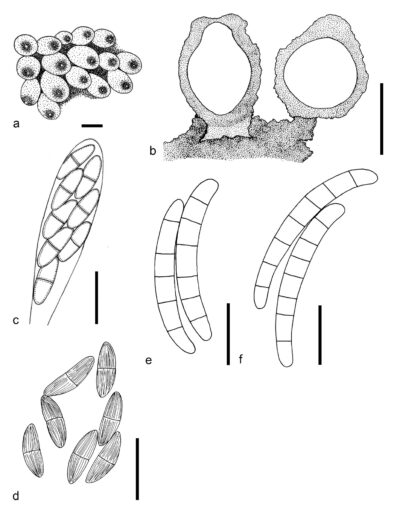Fungalpedia – Note 317, Macronectria
Macronectria Salgado & P. Chaverri
Citation when using this entry: Perera et al. 2024 (in prep) – Fungalpedia, genera described in 2016.
Index Fungorum, Facesoffungi, MycoBank, GenBank, Fig. 1
Classification: Nectriaceae, Hypocreales, Hypocreomycetidae, Sordariomycetes, Pezizomycotina, Ascomycota, Fungi.
Salgado-Salazar et al. (2016) proposed Macronectria based on Thelonectria jungneri and four other taxa with cylindrocarpon-like asexual morphs. These taxa showed a distant phylogenetic relationship with species in Thelonectria s. str. in the analysis of eight concatenated loci (act, ITS, LSU, rpb1, rpb2, SSU, tef1, and tub2) (Salgado-Salazar et al. 2016). The sexual morph of Macronectria is characterized by subglobose to pyriform, sometimes elongated and fask-shaped, perithecial ascomata that are gregarious and superficial on an erumpent stroma. Ascomata do not collapse when dry, are (370–)400–520(600) μm in size with a smooth surface, and constricted below the apex to form a small or broad papilla. The color of the ascomata ranged from peach to orange, ochreous to umber, and turned red in KOH and yellow in lactic acid. The peridium is up to 50 μm wide and consists of two intergrading strata. The outer stratum comprises intertwined hyphae with slightly elliptical cells, whereas the inner stratum consists of fattened fusoid cells. Macronectria produces hyaline and septate apical paraphyses that are constricted at the septa. Asci are 55–100×12–30 μm in size, 8-spored and clavate with a simple apex. Ascospores are 20–35×8–11 μm in size, ellipsoid to fusiform, 1-septate and slightly constricted at septa. They are hyaline, striate, and occasionally covered by a narrow sheath. Macronectria possess cylindrocarpon-like hyphomycetous asexual morphs. Phialidic conidiogenous cells are borne apically on irregularly branched clusters of cells or directly from hyphae. They are cylindrical or somewhat inflated, with visible periclinal thickenings and collarettes. Globose to oval microconidia with an abscission scar are present or absent. Macroconidia are 3–8-septate and cylindrical or fusiform with rounded ends. Chlamydospores are absent (Salgado-Salazar et al. 2016; Perera et al. 2023). Macronectria species are saprobic on decaying woody substrates and other plant organic matter (Salgado-Salazar et al. 2016; Perera et al. 2023). Macronectria accommodates five species (Salgado-Salazar et al. 2016).
Type species: Macronectria jungneri (Henn.) C. Salgado & P. Chaverri
Other accepted species: Species Fungorum, search Macronectria
Figure 1 – Macronectria jungneri (a, d: BPI 893178, c: BPI 893180, e, f: CBS 136792), Macronectria asiatica (b: MFLU 16-1050). a Ascomata. b Vertical section of ascomata. c Asci and ascospores. d Ascospores. e, f Macroconidia on SNA. Scale bars: a = 500 μm, b = 200 μm, c–f = 50 μm. Redrawn from Salgado-Salazar et al. (2016) and Perera et al. (2023)
References
Entry by
Rekhani Hansika Perera, Center of Excellence in Fungal Research, Mae Fah Luang University, Chiang Rai, 57100, Thailand.
(Edited by Kevin D. Hyde, Samaneh Chaharmiri-Dokhaharani, & Achala R. Rathnayaka)
Published online 27 August 2024
